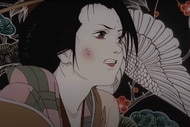Create a free profile to get unlimited access to exclusive videos, sweepstakes, and more!
Sailor Moon's live stage musical is a sparkling dream made real

The all-female, all-Japanese cast of Sailor Moon's first Broadway-style musical, Pretty Guardian Sailor Moon: The Super Live, welcomes the titular heroine to the stage like a Greek chorus. As they often did in the original anime, the girls list off Sailor Moon's many characters flaws in unison. She is lazy, she is selfish, she eats too many unhealthy snacks, and she cries all the damn time. Still, the girls sing as she appears above them on a platform; she is their Sailor Moon, the unlikely leader of the Pretty Guardians, and she is "so precious to us."
By the time we meet Sailor Moon (Tomomi Kasai) in the flesh, all the other Sailor Senshi have leap onstage to sing their introductory solos — Mercury, the quiet nerd, Mars, the hothead; Venus, the flirt; and Jupiter, the tall, socially awkward one. The girls dance-kick their way through monster gymnasts and singing to the audience about their favorite things.
It's a running joke in the anime that polished, lovable, even-keeled Sailor Venus would make a better leader than Sailor Moon, who struggles with an inferiority complex. In the musical, this plays out as Sailor Moon goes to high five Sailor Venus and is left hanging. Sailor Moon stares at her hand as Sailor Venus glides past her, belting her solo, and then she trips, falling to her knees as the spotlight careens past her as well.
Two stand-out lines from these big opening numbers include Mercury (Momoko Kaechi) kicking a ghoul in the face while declaring "some things are more important than homework," and Mars (Yui Hasegawa) clotheslining a creature with her outstretched arm while she sings, "I can't be held responsible for what happens when you make me angry!" These kooky bits of dialogue are translated on screens flanking the stage; though Sailor Moon has an international, intergenerational fandom all over the world, most of her adoring followers still don't speak Japanese.
It's difficult to describe the emotions that bubble up as one watches these familiar characters act out big plot points on stage. I was surprised to find that I teared up the moment the first Sailor scout appeared on stage — it was tiny, baby-faced Mercury. The rainbow, twinkling lights came up, Mercury daintily bounded into view, her familiar Pretty Guardian uniform sparkling, and I remembered that the manga and anime's creators were shocked upon the series' release when she became the fan favorite.
Throughout the show, Ami serves as a quiet, almost-maternal voice of reason for the emotionally volatile Sailor Moon. She's moral, responsible, and a dedicated student —it's been theorized that many Japanese kids in the 1990s felt immense pressure from a school system that was growing more demanding by the semester and so for many, Ami represented the model student. If young viewers saw themselves in the flawed Sailor Moon, then it was Ami who looked like the girl their parents wished they were.
The musical's director and choreographer, Takahiro, says The Super Live is a 2-D musical, which is a term used in Japanese media to refer to staged adaptations of manga or anime. "A 2-D experience would mean reading a manga or watching anime," Makoto Matsuda told SYFY WIRE at a show preview on Friday. "So a 2.5-D experience means watching actors on stage."
It's not clear what a 3D Sailor Moon experience would look like, following that logic. Perhaps in Japan, a 3D anime experience would look like virtual reality, or live action roleplay. Frankly, I would line up to experience either one.
Another facet of the show that will feel like an odd quirk for American audiences is the division of art forms across the two-act structure. Act One in a typically 2D anime adaptation, Matsuda explained, runs like any other Broadway musical. We watch the actresses play out a familiar storyline, fighting Queen Beryl and singing about it as they go. There's an intermission, and then Act Two plays out like a pop concert.
I saw segments of both acts, and I admit that it was a little disorienting to watch the Sailor scout actresses sing and dance like a J-Pop group, alongside the monster actresses, after just having seen everyone play their characters in a traditional way. On the other hand, I guess not everyone can say they've seen Sailor Moon kicking in a chorus line with a couple of singing space monsters.
Clearly, these Japanese cultural quirks have not affected the show's appeal to Western audiences; the cast and crew proudly announced on Friday that their limited run in the United States was already completely sold out.
Kumiko Yoshii, a producer from Gorgeous Entertainment, told SYFY WIRE that Americans were flying in from more than 40 states to see the show in New York City. When asked why Americans have always found something to love in Sailor Moon, the editor in chief at the manga publisher Kodansha, Fumio Osano, said that young people in any culture dream about prevailing in high stakes situations. It's one of the reasons Westernized superheroes have all but taken over the American film industry for more than a decade.
But Sailor Moon, like Pokémon, is a very specific kind of super-story. No one's losing limbs or breaking bones here. The girls' powers are mostly based in natural elements, and they're usually just protecting their classmates from harm. Their advisory cats Luna and Artemis (tragically absent from the musical) don't teach them Black Widow-style fighting techniques, but instead train them to act courageously in the face of danger, protect the downtrodden, and use their sparkly accessories to funnel their unique powers. It's a lot of bubble rays, tiara Frisbees, and pretty, neon laser beams.
Like Wonder Woman, the Sailor Scouts are as beautiful inside as they are on the outside, but Sailor Moon takes that idea a step further. The girls' superhero transformations, which air every episode, back to back, unchanged, in the original anime, involve stuff like sparkling manicures, new hair-dos, and those iconic, rippling schoolgirl skirts. They don't wear armor, and they always look polished and, well, pretty, when fighting the forces of evil.
Some of the best episodes of the original anime are the ones where each Sailor scout makes her debut. At the beginning of the series, only Sailor Moon and Mercury know their true identities, and they do cute detective work to discover which of their classmates have dormant Pretty Guardian powers. Neither Jupiter nor Mars is an obvious guess, but as the anime reminds viewers over and over, the power of love and decency can make a beautiful superhero out of anyone — even the awkward teens, the angry, rebellious teens, or like Sailor Moon herself, the teens who would rather eat rice balls and sleep until noon.
You can see Pretty Guardian Sailor Moon: The Super Live at the PlayStation Theater March 29 and 30, but only if you bought tickets months ago. But don't worry! Based on the instant success of the show's first mini-run in the United States, it's likely the girls will be back soon.




























